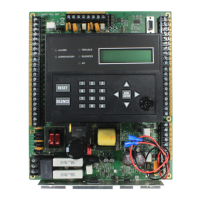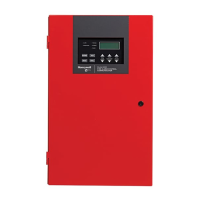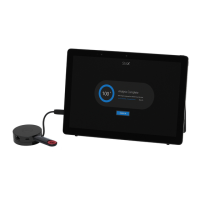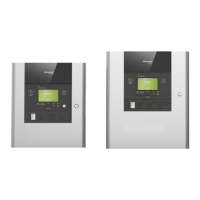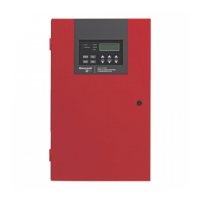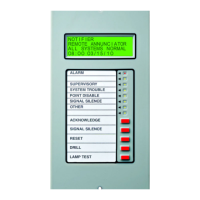6820 / 6820EVS Manual P/N LS10144-001SK-E:C 10/09/2017 13
3. Use UL listed notification appliances compatible with the 6820 or 6820EVS from those specified in Appendix A of this manual.
4. A full system checkout must be performed any time the panel is programmed.
Restricted Options:
• The loss of AC signal is defaulted to 3 hours, however the system allows settings from 0 - 30 hours. For UL certified installations
this number must be set from 1 to 3 hours.
• The system allows the use of non-latching spot type smoke detectors. This feature may not be used in commercial applications
whereby a general alarm is sounded. It is intended for elevator recall, door holding applications, and hotel/motel room applications.
• The system allows the Alarm Verification time to be set from 60 to 250 seconds. For UL certified installations the setting must be a
minimum of 60 seconds.
• The systems allows the Auto-resound time to be set to 24 or 4 hours. For UL certified installations that are utilizing SWIFT devices,
the value must be set to 4 hours.
• Call forwarding shall not be used.
• When two count is used: detector spacing shall be cut in half, you shall not use the alarm verification feature, and no delay shall be
used.
• P.A.S. (positive alarm sequence) feature shall be used only with automatic detectors.
2.2.2 Requirements for Central Station Fire Alarm Systems
1. Use both phone lines. Enable phone line monitors for both lines.
2. You must program a phone number and a test time so that the 6820/6820EVS shall automatically initiate and complete a test signal
transmission sequence to its associated receiver at least once every 6 hrs.
3. The AC Loss Hours option must be set from 1-3 hours.
4. If using wired Ethernet or cellular, you must program the corresponding account/subscriber ID and a test time so that the FACP
shall automatically initiate a test signal transmission sequence to its associated receiver at least once every 6 hrs.
2.2.3 Requirements for Local Protected Fire Alarm Systems
At least one UL listed supervised notification appliance must be used.
2.2.4 Requirements for Remote Station Protected Fire Alarm Systems
1. Do not exceed the current draw load restrictions shown in Section “Calculating Current Draw and Standby Battery” on page 20.
2. The AC Loss Hours option must be set from 1-3 hours.
2.2.5 Requirements for the Installation of Carbon Monoxide (CO) Detection and Warning
Equipment, NFPA 720
When using carbon monoxide detection the system must be monitored by a Supervising Station.
2.2.6 NFPA Requirements
The following is the minimum configuration to meet the NFPA requirements.
Model/Module Description Local Releasing
Remote
Station
Auxiliary
Central
Station
Emergency
Signaling
068200CB Enclosure YYYYYY
068080 Motherboard YYYYYY
RA-100BD 4 x20 display YYYYYY
5815XL SLC Expander OOOOOO
6815 SLC Expander OOOOOO
SK-NIC Network cardOOOOOO
SK-FML/ -FSLFiber moduleOOOOOO
7644 Pol Rev device N N Y N N N
5220 City tie, Pol. Rev
Device
NNYYNN
Keltron 3158 Rev Pol Module N N Y Y N N
Cell-Mod/Cell-Cab-
SK
1
Cellular
transmitter
NN NYN
Y = YES, N = NO, O = OPTIONAL
1. When configured for Emergency relocation and evacuation equipment the system must meet Local configuration (Model
6820EVS) with a minimum of one amplifier (EVS-50W/EVS-125W or EVS-INT50W) and one Voice Control Module
(Model EVS-VCM).
Table 2.1 NFPA Requirements for 6820

